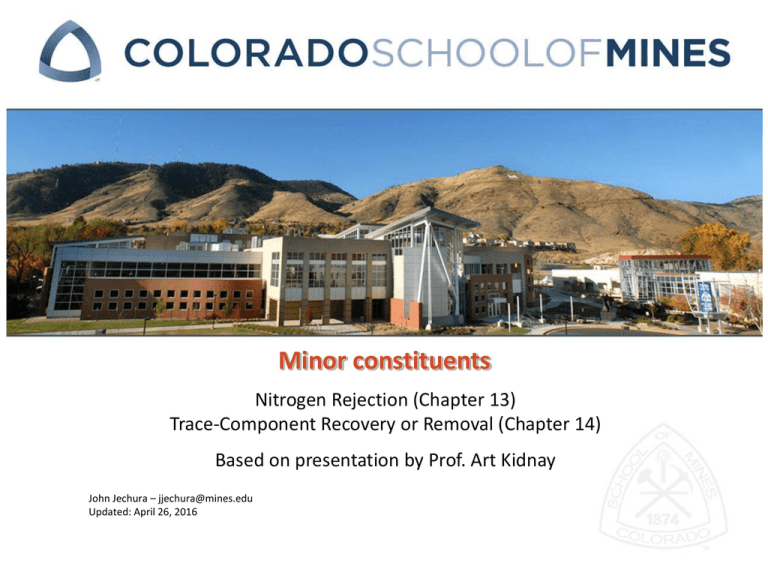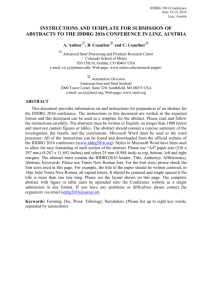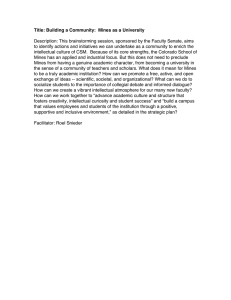Minor constituents
advertisement

Minor constituents Nitrogen Rejection (Chapter 13) Trace-Component Recovery or Removal (Chapter 14) Based on presentation by Prof. Art Kidnay John Jechura – jjechura@mines.edu Updated: April 26, 2016 Plant Block Schematic John Jechura – jjechura@mines.edu Updated: April 26, 2016 2 Topics • Nitrogen Rejection (NRU) Nitrogen Rejection for Gas Upgrading Nitrogen Rejection for EOR • Trace-Component Recovery or Removal H2, O2, NORM, As Helium Mercury • Amalgam Formation • Removal Processes BTEX Ref: Smithsonian Museum of Natural History John Jechura – jjechura@mines.edu Updated: April 26, 2016 3 Topics • Nitrogen Rejection (NRU) Nitrogen Rejection for Gas Upgrading Nitrogen Rejection for EOR • Trace-Component Recovery or Removal H2, O2, NORM, As Helium Mercury • Amalgam Formation • Removal Processes BTEX Ref: Smithsonian Museum of Natural History John Jechura – jjechura@mines.edu Updated: April 26, 2016 4 Nitrogen Removal / Rejection Nitrogen rejection is required to: • Lower N2 level to meet pipeline specifications • Recover N2 for use in enhanced oil recovery (EOR) • Obtain raw N2 / He stream for He recovery John Jechura – jjechura@mines.edu Updated: April 26, 2016 5 Subquality gas and EOR • 16% of the non-associated reserves (2000) were subquality in nitrogen and consequently require blending or processing to meet the 3 mol % total inerts specification for pipelines • In 1998 EOR methods contributed about 12% of the total US oil production. about 55% from thermal methods, 28% from carbon dioxide flooding, 12% from natural gas flooding, 4.5% was from nitrogen flooding. John Jechura – jjechura@mines.edu Updated: April 26, 2016 6 Subquality gas and EOR Subquality gas • 16% of US non-associated reserves (2000) high in N2 Requires blending or processing to meet the 3 mol % total inerts pipeline specification EOR • Contributed ~12% of the total US oil production (1998) ~ 55% from thermal methods ~28% from carbon dioxide flooding ~12% from natural gas flooding ~4.5% from nitrogen flooding John Jechura – jjechura@mines.edu Updated: April 26, 2016 7 Removing N2 from natural gas Three basic methods for removing nitrogen from natural gas: • Cryogenic distillation • Adsorption • Membrane separation John Jechura – jjechura@mines.edu Updated: April 26, 2016 8 Process comparison Process Flow range MMscfd (MSm3/d) Complexity Heavy hydrocarbon recovery Stage of development Distillation >15 (400) Complex In product gas Mature Pressure swing adsorption (PSA) 2 – 15 (60 – 400) Simple: batch operation In regeneration gas Early commercial Membrane 0.5 – 2.5 (15 – 700) Simple: continuous operation In product gas Early commercial John Jechura – jjechura@mines.edu Updated: April 26, 2016 9 Conventional Cryo Process Turboexpander Cold C3 Vapor Feed Gas Cold Separator Demethanizer Reboilers Gas-Gas Exchangers NGL Cold C3 Liquid Residue Gas to Outlet Compression John Jechura – jjechura@mines.edu Updated: April 26, 2016 10 Conventional Cryo Process Turboexpander Cryogenic distillation Cold C3 Vapor Feed Gas Cold Separator Demethanizer Reboilers Gas-Gas Exchangers NGL Cold C3 Liquid John Jechura – jjechura@mines.edu Updated: April 26, 2016 11 Distillation nitrogen + methane feed VERY COLD nitrogen normal boiling point, 0F N2 -320 CH4 -259 methane John Jechura – jjechura@mines.edu Updated: April 26, 2016 12 Two-column cryogenic distillation N2 -260°F 10 psig 65% N2 35% C1 -210°F -200°F -250°F Demethanizer Overhead 15% N2 -150°F, 250 psig John Jechura – jjechura@mines.edu Updated: April 26, 2016 -175°F 200 psig -240°F -160°F -300°F 98% C1 -200°F 10 psig -245°F 15 psig 13 Adsorption Two Modes of Regeneration 1. 2. Temperature Swing Adsorption (TSA) • Increase temperature for regeneration • Good for trace impurities with high heat of adsorption Pressure Swing Adsorption (PSA) • Decrease pressure for regeneration • Good for enriching streams • Components have low heat of adsorption • Rapid cycles (seconds to few minutes) John Jechura – jjechura@mines.edu Updated: April 26, 2016 14 Adsorption Isotherms (Courtesy of UOP) Lb Water Adsorbed / 100 lb Activated Adsorbent 25 20 15 32 °F 100 °F 77 °F 400 °F 150 °F 600 °F 500 °F 10 5 0 1.0 E-8 1.0 E-7 1.0 E-6 1.0 E-5 1.0 E-4 1.0 E-3 1.0 E-2 1.0 E-1 1.0 E0 1.0 E+1 1.0 E+2 1.0 E+3 1.0 E+3 Partial Pressure of Water, psia John Jechura – jjechura@mines.edu Updated: April 26, 2016 15 Adsorption John Jechura – jjechura@mines.edu Updated: April 26, 2016 16 Adsorption John Jechura – jjechura@mines.edu Updated: April 26, 2016 17 Adsorption John Jechura – jjechura@mines.edu Updated: April 26, 2016 18 Adsorption John Jechura – jjechura@mines.edu Updated: April 26, 2016 19 Adsorption John Jechura – jjechura@mines.edu Updated: April 26, 2016 20 Adsorption A PSA system is a series of batch processes. When placed together they produce a steady-state flow of feed, product, and tail gas. UOP: systems are available in 16 bed configurations. “Adsorbents last for the life of the mechanical equipment (more than 30 years).” John Jechura – jjechura@mines.edu Updated: April 26, 2016 21 Field Demonstration of a Membrane Process to Separate Nitrogen from Natural Gas Final Report: October 11, 2007 National Energy Technology Laboratory: DE-FC2601NT41225 John Jechura – jjechura@mines.edu Updated: April 26, 2016 22 Composite membrane structure used to separate nitrogen from natural gas membrane is a silicone rubber/polyetherimide (PEI) composite (1 µm = 1 x 10-6 m) John Jechura – jjechura@mines.edu Updated: April 26, 2016 23 Membrane unit to treat gas containing 8 - 16% N2 to bring it to Btu gas specifications and 5 to 10% N2 in the treated stream. John Jechura – jjechura@mines.edu Updated: April 26, 2016 24 Commercial unit sold to Towne Exploration for treating gas containing 8-16% nitrogen. John Jechura – jjechura@mines.edu Updated: April 26, 2016 25 Comparison of Design and Actual Performance for the First of Towne Exploration’s Commercial Nitrogen-Separation Membrane Units at Rio Vista, California (August 25, 2007). John Jechura – jjechura@mines.edu Updated: April 26, 2016 26 Topics • Nitrogen Rejection (NRU) Nitrogen Rejection for Gas Upgrading Nitrogen Rejection for EOR • Trace-Component Recovery or Removal H2, O2, NORM, As Helium Mercury • Amalgam Formation • Removal Processes BTEX Ref: Smithsonian Museum of Natural History John Jechura – jjechura@mines.edu Updated: April 26, 2016 27 Possible trace components • Hydrogen • Oxygen • Radon (NORM) • Arsenic • Helium • Mercury • BTEX (benzene, toluene, ethylbenzene, and xylene) John Jechura – jjechura@mines.edu Updated: April 26, 2016 28 Hydrogen & Oxygen • Hydrogen Rare unless refinery cracked gas is fed to plant • Oxygen Not naturally occurring Major source – leaks in sub-atmospheric gathering systems John Jechura – jjechura@mines.edu Updated: April 26, 2016 29 Problems associated with oxygen • Enhances pipeline corrosion • Forms heat stable salts (HSS) with amines • Forms corrosive acidic compounds with glycols • Forms water with heavy hydrocarbons during reactivation of adsorbent beds John Jechura – jjechura@mines.edu Updated: April 26, 2016 30 Oxygen removal techniques • Non-regenerative scavengers • Catalytic reaction to form water and CO2 (H2O removed in dehydration process) (sulfur compounds poison oxidation catalysts) John Jechura – jjechura@mines.edu Updated: April 26, 2016 31 Radon (NORM) Naturally Occurring Radioactive Material Natural gas contains Radon (Ra222) at low concentrations gas is rarely health problem half-life of about 3.8 days Ra222→ Po218 → Pb214 → Bi214 → Po214 → Pb210 → Bi210 → Po210 → Pb206 3.8 d 3.0 m John Jechura – jjechura@mines.edu Updated: April 26, 2016 27 m 20 m 164 ms 22.3 yr 5.0 d 138 d NORM • Radon gas → radioactive solids • Solids collect on pipe walls inlet filters • Scale generates large quantities of low level radioactive waste which must be discarded in disposal wells. John Jechura – jjechura@mines.edu Updated: April 26, 2016 33 Arsenic • Toxic nonvolatile solid • Predominately trimethylarsine (As(CH3)3) • Typically collects as fine grey dust • Removed from gas using nonregenerative adsorption • Facilities reduce concentrations in sweet raw gas from 1,000 to less than 1mg/m3 John Jechura – jjechura@mines.edu Updated: April 26, 2016 34 Helium • Valuable • Natural gas most viable source • “Helium-rich” gas > 0.3 vol% helium Rarely > 5 vol% • United States (2003) produced 84% of world production of Grade-A helium (99.995% purity) Remainder from Algeria, Poland and Russia. • New large helium plants: Qatar (2005) Darwin, Australia (2007) John Jechura – jjechura@mines.edu Updated: April 26, 2016 35 Helium uses Breathing Mixtures, 2% Welding, 20% Controlled Atmosphere, 13% Cryogenics, 28% Pressure or Purge, 26% Other, 7% John Jechura – jjechura@mines.edu Updated: April 26, 2016 Leak Detection, 4% 36 Feed compositions to Ladder Creek (mol %) He-Rich Gas He-Lean Gas Nitrogen 61.92 31.58 Helium 3.54 1.81 Carbon Dioxide 0.98 0.91 Methane 26.65 52.84 Ethane 2.60 6.40 C3+ 4.30 6.46 N2/He ratio 17.49 John Jechura – jjechura@mines.edu Updated: April 26, 2016 17.45 37 Helium recovery plant (Ladder Creek) Liquid Nitrogen Storage Feed Gas CO2 Removal Mole Sieve Dehydration Waste Gas Recycle Compressor Nitrogen To Vent or Liquid Storage PSA Helium Purifier Crude Helium Pretreatment Helium Liquefier High Pressure Storage NGL/NRU/HRU Cold Box Residue Gas NGL Product John Jechura – jjechura@mines.edu Updated: April 26, 2016 Helium Product Compressor Helium Storage Truck Filling Station Tube Trailer Filling Station 38 Mercury Two major problems of mercury in natural gas • amalgam formation with aluminum • environmental pollution - compounds readily absorbed by most biological systems John Jechura – jjechura@mines.edu Updated: April 26, 2016 39 Mercury • May be present as elemental mercury organometallic compounds, CH3HgCH3 (dimethylmercury),CH3HgC2H5(methylethylmercury), C2H5HgC2H5 (diethylmercury) inorganic compounds such as HgCl2 • Elemental mercury: majority will condense in cryogenic section • Organometallic: will concentrate in hydrocarbon liquids John Jechura – jjechura@mines.edu Updated: April 26, 2016 40 Typical mercury levels Location Elemental Mercury Concentration in micrograms/Nm3 (ppbv) South America 69 – 119 (8 to 13) Far East 58 – 93 (6 to 10) North Africa 0.3 – 130 (0.03 to 15) Gronigen (Germany) 180 (20) Middle East 1 – 9 (0.1 to 1) Eastern US Pipeline 0.019 - 0.44 (0.002 to 0.05) Midwest US Pipeline 0.001 - 0.10 (0.0001 to 0.01) North America 0.005 - 0.040 (0.0005 to 0.004) John Jechura – jjechura@mines.edu Updated: April 26, 2016 41 Mercury removal processes • Nonregenerative chemisorption Removes elemental mercury to < 0.01mg/Nm3 Typical bed capacities > 10% Most use sulfur impregnated on high surface area support • Regenerative chemisorption (1 process) Silver on mole sieve chemisorbs elemental mercury and dehydrates at the same time Can be added to existing dehydration unit Generates mercury waste stream John Jechura – jjechura@mines.edu Updated: April 26, 2016 42 Mercury Recovery No Treatment of Regeneration Gas regeneration H2O + regeneration gas and 34.45 g/day Hg adsorption adsorption 545 MMscfd, 700F, 845 psia 27.67 lb H2O/MMscf 2.5 micrograms Hg/Nm3 H2O + 0.154 g/day of Hg 34.4 MMscfd regeneration gas dry, Hg - free gas Hg_removal_ENG John Jechura – jjechura@mines.edu Updated: April 26, 2016 43 Mercury Recovery Treatment of Regeneration Gas adsorption adsorption regeneration Nonregenerated Hg bed 34.39 g/day accumulation 545 MMscfd, 700F, 845 psia 27.67 lb H2O/MMscf 2.5 micrograms Hg/Nm3 H2O + 0.206 g/day of Hg 34.4 MMscfd regeneration gas dry, Hg-free gas Hg_recovery_ENG John Jechura – jjechura@mines.edu Updated: April 26, 2016 44 BTEX (benzene, toluene, ethylbenzene, xylenes) • Possible problems: Freeze out and plugging in cryogenic units Excessive aromatic hydrocarbon emissions • Venting from TEG regenerator largest source • Venting from amine regenerators lesser source • Recovery systems eliminate problem John Jechura – jjechura@mines.edu Updated: April 26, 2016 45 BTEX Absorption in glycol dehydrators • TEG absorbs aromatic (BTEX) hydrocarbons • Absorption enhanced at low temperatures, high TEG concentrations, and higher circulation rates • Most of the absorbed BTEX vented with steam at top of regeneration column John Jechura – jjechura@mines.edu Updated: April 26, 2016 46 BTEX Emission Control Methods • Adjusting glycol unit operating conditions to minimize the quantity of BTEX absorbed • Burning glycol still offgases prior to venting • Condensing glycol offgases and recovering BTEX as a liquid product • Adsorbing BTEX on a carbon adsorbent John Jechura – jjechura@mines.edu Updated: April 26, 2016 47 Topics • Nitrogen Rejection (NRU) Nitrogen Rejection for Gas Upgrading Nitrogen Rejection for EOR • Trace-Component Recovery or Removal H2, O2, NORM, As Helium Mercury • Amalgam Formation • Removal Processes BTEX Ref: Smithsonian Museum of Natural History John Jechura – jjechura@mines.edu Updated: April 26, 2016 48

